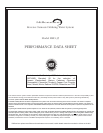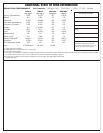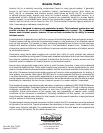
HELLENBRAND, INC.
404 Moravian Valley Road
Waunakee, Wisconsin 53597-0187
Phone (608) 849-3050
Fax (608) 849-7398
Arsenic Facts
Arsenic (As) is a naturally occurring contaminant found in many ground waters. It generally
occurs in two forms (valences or oxidation states): pentavalent arsenic (also known as
As(V), As(+5), or arsenate) and trivalent arsenic (also known as As(III), As(+3), or arsenite).
In natural ground water, arsenic may exist as trivalent arsenic, pentavalent arsenic, or a
combination of both. Although both forms of arsenic are potentially harmful to human health,
trivalent arsenic is considered more harmful than pentavalent arsenic. More information about
arsenic and its toxicity can be found on the U.S. Environmental Protection Agency website at:
http://www.epa.gov/safewater/arsenic.html.
This system is designed to remove only pentavalent arsenic. This treatment system does not
provide a feature for conversion of trivalent arsenic to pentavalent arsenic. The system may
remove some trivalent arsenic; however, it has not been evaluated for its ability to remove
trivalent arsenic.
Trivalent arsenic is generally more difficult to remove from drinking water than pentavalent arsenic.
Trivalent arsenic can be converted to pentavalent arsenic in the presence of an effective oxidant
such as free chlorine. The arsenic in water containing detectable free chlorine or that has been
treated with another effective oxidant will be in the pentavalent arsenic form. Treatment with
chloramine (combined chlorine) is not sufficient to ensure complete conversion of trivalent arsenic
to pentavalent arsenic.
Consumers using public water supplies can contact their utility to verify whether free chlorine
treatment chemicals are being used. Private water supplies and waters that do not have detectable
free chlorine residuals should be analyzed to determine the form(s) of arsenic present and the
potential need for oxidation of trivalent arsenic to pentavalent arsenic.
Arsenic does not generally impart color, taste or smell to water, therefore, it can only be detected
by a chemical analytical test. Public water supplies are required to monitor treated water for total
arsenic (trivalent arsenic plus pentavalent arsenic) and the results are available to the public from
the utility. Consumers using private water sources will need to make arrangements for testing. A
total arsenic test usually costs about $15-$30 and it is recommended the test be conducted by
a certified laboratory. Local health departments or environmental protection agencies can help
provide consumers with a list of certified laboratories. Some laboratories may also be able to analyze
specifically for (speciate) the two forms of arsenic present in a water sample if requested.
This treatment system was tested under laboratory conditions as defined in NSF/ANSI 58 Reverse
Osmosis Drinking Water Treatment Systems and was found to reduce 0.30 mg/L influent arsenic
challenge concentration in the test water to less than 0.010 mg/L, under standard testing
conditions. Actual performance of the system may vary depending on specific water quality
conditions at the consumer’s installation. Following installation of this system, the consumer
should have the treated water tested for total arsenic to verify arsenic reduction is being achieved
and the system is functioning properly.
The pentavalent arsenic removal component of this system (the R.O. membrane) must be replaced
at the end of its useful life. Typical membrane life expectancy is three years. Local conditions may
dictate more frequent changes. For replacement parts contact the local dealer who supplied the
unit or contact the factory for the dealer nearest you.
Form No. S1473-HB
Updated 07/25/07






